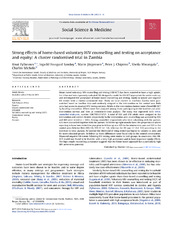| dc.contributor.author | Fylkesnes, Knut | en_US |
| dc.contributor.author | Sandøy, Ingvild Fossgard | en_US |
| dc.contributor.author | Jürgensen, Marte | en_US |
| dc.contributor.author | Chipimo, Peter Jay | en_US |
| dc.contributor.author | Mwangala, Sheila | en_US |
| dc.contributor.author | Michelo, Charles Cheembo | en_US |
| dc.date.accessioned | 2015-04-09T13:25:45Z | |
| dc.date.available | 2015-04-09T13:25:45Z | |
| dc.date.issued | 2013-06 | eng |
| dc.identifier.issn | 0277-9536 | |
| dc.identifier.uri | https://hdl.handle.net/1956/9738 | |
| dc.description.abstract | Home-based voluntary HIV counselling and testing (HB-VCT) has been reported to have a high uptake, but it has not been rigorously evaluated. We designed a model for HB-VCT appropriate for wider scale-up, and investigated the acceptance of home-based counselling and testing, equity in uptake and negative life events with a cluster-randomized trial. Thirty six rural clusters in southern Zambia were pair-matched based on baseline data and randomly assigned to the intervention or the control arm. Both arms had access to standard HIV testing services. Adults in the intervention clusters were offered HB-VCT by local lay counsellors. Effects were first analysed among those participating in the baseline and post-intervention surveys and then as intention-to-treat analysis. The study was registered with www.controlled-trials.com, number ISRCTN53353725. A total of 836 and 858 adults were assigned to the intervention and control clusters, respectively. In the intervention arm, counselling was accepted by 85% and 66% were tested (n = 686). Among counselled respondents who were cohabiting with the partner, 62% were counselled together with the partner. At follow-up eight months later, the proportion of adults reporting to have been tested the year prior to follow-up was 82% in the intervention arm and 52% in the control arm (Relative Risk (RR) 1.6, 95% CI 1.4–1.8), whereas the RR was 1.7 (1.4–2.0) according to the intention-to-treat analysis. At baseline the likelihood of being tested was higher for women vs. men and for more educated people. At follow-up these differences were found only in the control communities. Measured negative life events following HIV testing were similar in both groups. In conclusion, this HB-VCT model was found to be feasible, with a very high acceptance and to have important equity effects. The high couple counselling acceptance suggests that the home-based approach has a particularly high HIV prevention potential. | en_US |
| dc.language.iso | eng | eng |
| dc.publisher | Elsevier | eng |
| dc.rights | Attribution-NonCommercial-NoDerivs CC BY-NC-ND | eng |
| dc.rights.uri | http://creativecommons.org/licenses/by-nc-nd/3.0/ | eng |
| dc.subject | Sub-Saharan Africa | eng |
| dc.subject | Zambia | eng |
| dc.subject | Cluster-randomized trial | eng |
| dc.subject | HIV/AIDS | eng |
| dc.subject | Voluntary counselling and testing (VCT) | eng |
| dc.subject | Home-based testing | eng |
| dc.subject | Equity | eng |
| dc.subject | Consent | eng |
| dc.title | Strong effects of home-based voluntary HIV counselling and testing on acceptance and equity: A cluster randomised trial in Zambia | en_US |
| dc.type | Peer reviewed | |
| dc.type | Journal article | |
| dc.date.updated | 2015-04-01T08:18:19Z | en_US |
| dc.description.version | publishedVersion | en_US |
| dc.identifier.doi | https://doi.org/10.1016/j.socscimed.2013.02.036 | |
| dc.identifier.cristin | 1046680 | |
| dc.source.journal | Social Science and Medicine | |
| dc.source.40 | 86 | |
| dc.source.pagenumber | 9-16 | |
| dc.subject.nsi | VDP::Medical sciences: 700::Health sciences: 800::Community medicine, social medicine: 801 | eng |
| dc.subject.nsi | VDP::Medisinske fag: 700::Helsefag: 800::Samfunnsmedisin, sosialmedisin: 801 | nob |

